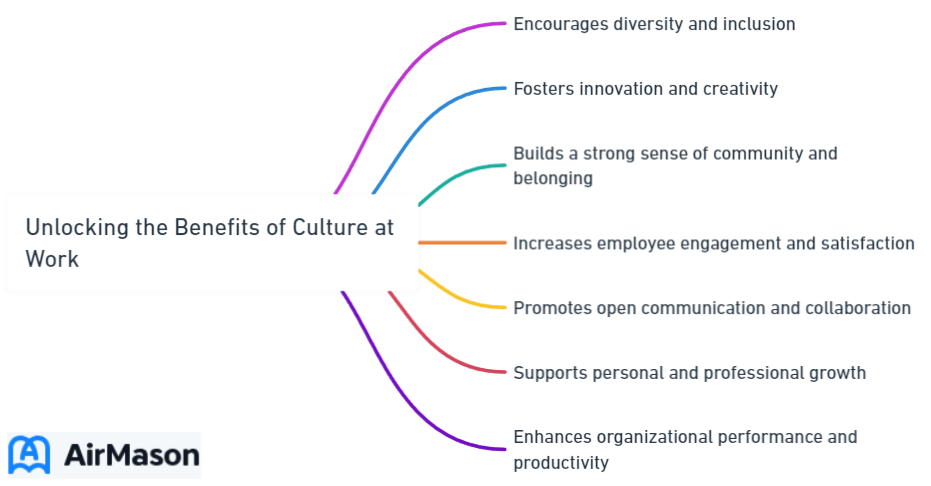
Unlock the secrets to a thriving work environment in 2024 by exploring the benefits of a strong company culture at work. As the workplace evolves, understanding the key elements that contribute to employee happiness, talent retention, and productivity becomes increasingly crucial. So, let’s dive into the world of workplace culture and uncover the strategies that will help your organization succeed in fostering a positive culture at work.
Key Takeaways
- Create a positive workplace culture to promote employee happiness, attract top talent and increase productivity.
- Celebrate diversity & inclusion, establish core values and encourage open communication for successful company cultures.
- Measure & monitor with surveys/feedback and key performance indicators (KPIs) for data-driven decisions that improve engagement, retention & performance.
The Importance of Company Culture
A company’s organization’s culture is the lifeblood of its success, shaping the way employees interact and work together. A healthy culture fosters employee happiness, attracts top talent, and enhances productivity, making culture important as a vital aspect of organizational success. Indeed, culture is one of the key factors that contribute to a thriving work environment.
Is there a way to solidify and sustain our company culture? The answer lies within three core components: employee happiness and well-being, the ability to draw in and keep top-level talent, and boosting productivity and performance.

Employee happiness and well-being
In today’s fast-paced work environment, employee well-being is more important than ever. A positive culture can lead to increased employee satisfaction and productivity. Many organizations have embraced the concept of remote working. They have implemented measures such as:
- flexible hours, which help their employees to maintain a better work-life balance
- a comfortable and supportive working environment
- effective communication practices
- strong manager relationships
All of these contribute to what employees want – a great experience with their company, leading to a healthy workplace for team members.
Moreover, employee participation in decision-making processes fosters a sense of inclusion and appreciation within the organization, which is crucial for employee engagement and satisfaction.
When organizations place emphasis on mental and physical health initiatives, accommodate flexible work arrangements, and foster supportive environments, they encourage the growth of more engaged and content employees. This, in turn, leads to a more positive and productive workplace, where everyone feels valued and inspired to give their best.
Attraction and retention of top talent
A strong company culture is like a magnet, attracting and retaining top talent. When employees feel that they are part of a supportive community, they are more likely to remain with an organization. Companies with healthy cultures have an advantage when it comes to keeping Generation Z employees engaged. In fact, they are 16 times more likely to do so. This highlights the importance of a company’s core values in employee retention. A strong company culture creates an inspiring work environment, emphasizes meaningful company values, and provides excellent opportunities for growth and development, all of which can help attract and retain top talent.
Creating a positive work environment with clear values and growth opportunities enables organizations to provide a thriving workplace for top talents. This not only benefits the individual employees but also contributes to the organization’s success and reputation.
Enhanced productivity and performance
A positive workplace culture is the secret sauce that enhances productivity and performance. When employees feel supported and motivated, they are more likely to be productive and engaged in their work. Encouraging collaboration and communication in the workplace enhances performance and strengthens relationships, leading to a healthy workplace culture. By fostering a positive company culture in the workplace, companies can ensure a thriving and successful environment.
The six main organization-wide drivers of employee engagement, according to Quantum Workplace, include:
- The leaders’ commitment to making the organization a great place to work
- Trust in leaders
- Belief in the organization’s future success
- Understanding of individual fit in the organization’s future plans
- Valuing people as the most important resource
- Mutual respect and trust among employees and leaders.
When organizations encourage collaboration, innovation, and a sense of purpose within an organization, they can foster a positive workplace culture that boosts productivity and performance, benefiting both the employees and the organization.
An Organization’s Culture
An organization’s culture is the bedrock upon which its values, norms, and behaviors are built. It encompasses the shared beliefs and practices that shape the way individuals within the organization interact and collaborate. This cultural framework influences decision-making, employee engagement, and ultimately, the overall success of the entity. A healthy organizational culture fosters an environment of trust, open communication, and mutual respect, enabling teams to work cohesively towards common goals. When an organization’s culture is well-defined and aligned with its mission, it becomes a powerful force that attracts and retains top talent, as individuals are drawn to environments that resonate with their own values and aspirations. Conversely, a negative or toxic culture can lead to disengagement, high turnover, and hindered productivity. Therefore, nurturing and actively cultivating a positive organizational culture is paramount for long-term prosperity and sustained success.
Building a Positive Workplace Culture

Building a thriving workplace culture may seem like a daunting task, but it doesn’t have to be. By focusing on three key aspects – establishing clear core values, encouraging open communication, and celebrating diversity and inclusion – organizations can create an environment where employees can thrive.
A closer examination of these aspects is warranted, so make sure to take a thorough look.
Establishing clear core values
Defining and communicating core values is the foundation upon which a strong company culture is built. Clear core values create a sense of purpose and belonging, helping employees to be in sync with the organization’s mission and goals. A healthy culture is essential for creating a great place to work because the dedication of the organization’s leadership team makes it possible to build a sustainable positive work culture. If an organization finds that their company’s values aren’t what they’d like them to be, they can use this as an opportunity to make positive changes and plan to act in ways that will help them reach their desired values. The organization should ensure that their values are reflected in their actions today or be part of a clear transformation strategy to embrace positive change and create a lasting impact.
When organizations define and communicate their company’s core values, they can help employees align with the mission and goals, encouraging a sense of purpose and belonging. This, in turn, helps create a strong and sustainable company culture that benefits both employees and the organization.
Encouraging open communication
Open communication is the lifeblood of a healthy workplace culture. It promotes trust, transparency, and collaboration, allowing employees to feel heard and valued within the organization. Leaders can foster open communication in the workplace by:
- Being honest, respectful, and invested in employees’ goals
- Enthusiastically welcoming feedback from employees, acting on their input, and soliciting employee feedback
- Holding regular meetings
- Practicing active listening
- Commending employees for sharing their ideas and concerns
By implementing these strategies, leaders can create an environment that encourages open communication among employees.
Encouraging open communication enables organizations to:
- Foster a positive and supportive work environment
- Make employees feel valued and empowered
- Increase trust and collaboration
- Achieve overall success for the organization
Celebrating diversity and inclusion
Embracing diversity and inclusion is vital for fostering a successful workplace culture. A diverse and inclusive work environment fosters innovation, creativity, and a sense of belonging, contributing to a more positive and successful workplace culture. Celebrating diversity and inclusion in the workplace can involve honoring cultural holidays, promoting equitable pay and employee advancement, engaging in informative diversity briefings and training programs, crafting a vibrant cultural celebration calendar, and hosting multicultural events. Embracing diversity and fostering inclusivity allows organizations to tap into the unique perspectives and talents of their employees, thus catalyzing innovation and creativity.
Incorporating diversity and inclusion into workplace culture not only benefits individual employees but also contributes to the overall success and reputation of the organization.
Environment for Work
The environment for work plays a pivotal role in determining an individual’s productivity and well-being. A conducive work environment encompasses physical, social, and psychological aspects that collectively influence one’s professional experience. It encompasses the physical layout of the workspace, including factors like lighting, ergonomics, and noise levels, which directly impact concentration and comfort. Moreover, the social dimension involves interactions with colleagues and superiors, fostering collaboration and a sense of belonging. Equally important is the psychological element, encompassing factors like job satisfaction, motivation, and mental well-being, which can significantly affect overall performance. Striking the right balance in these three dimensions creates an environment that encourages creativity, efficiency, and personal growth, leading to a more fulfilling and successful professional journey.
Identifying and Addressing Toxic Work Culture

To maintain a healthy and productive work environment, it is essential to identify and address toxic work culture. Recognizing the red flags of a toxic work culture and implementing change can help organizations improve the work environment and foster a more positive and supportive culture. We should examine the steps needed to identify potential issues and implement changes.
Recognizing red flags
Recognizing the signs of a toxic work culture is crucial for maintaining a healthy and productive work environment. Some signs of a healthy work culture include:
- low turnover
- high morale
- effective communication
- trust
However, when these elements are absent, it may indicate a toxic work culture that needs to be addressed. By identifying the red flags, organizations can take proactive steps to address issues and improve the work environment.
Addressing toxic work culture requires a multifaceted approach, involving revisiting core values, improving communication, and promoting diversity and inclusion. By taking these steps, organizations can create a more positive and supportive environment where employees can thrive.
Implementing change
Implementing change to address toxic work culture is a crucial step towards creating a healthier and more productive work environment. To effectively implement positive change in a challenging work environment, leaders can:
- Take responsibility
- Communicate and observe
- Re-establish a sense of security
- Get everyone on board
- Address toxic behaviors
- Lead by example
- Provide training and support
- Celebrate progress
Addressing toxic workplace culture and implementing changes can help organizations transform their work environment into a more positive and supportive space. This, in turn, can lead to increased employee satisfaction, productivity, and overall success for the organization.
Cultural Change
Cultural change is a dynamic and inevitable process that shapes societies over time. It encompasses shifts in beliefs, values, customs, and traditions within a community or a larger demographic. This transformative phenomenon is often driven by a combination of internal and external factors. Globalization, technological advancements, and evolving societal norms are key catalysts for cultural change in the contemporary world. Additionally, pivotal events, such as wars, revolutions, or significant economic shifts, can trigger seismic shifts in the way a culture operates. It’s important to recognize that cultural change is not a linear progression; rather, it is a complex interplay of various elements that unfold organically, impacting every facet of human existence from language and art to social structures and behavior. Embracing and understanding these shifts is crucial for fostering inclusivity and adaptability in an ever-changing global landscape.
Measuring and Monitoring Workplace Culture

Measuring and monitoring workplace culture is crucial for continuous improvement and ensuring alignment with organizational goals. By using tools such as employee surveys, feedback, and key performance indicators (KPIs), organizations can track the impact of their workplace culture initiatives and make data-driven decisions for improvement.
We should further examine these tools and their usage in measuring and monitoring workplace culture.
Employee surveys and feedback
Regular employee surveys and feedback provide valuable insights into the current state of the workplace culture, allowing organizations to:
- Identify areas for improvement
- Track progress over time
- Gain insight into employees’ needs and preferences
- Identify potential areas of growth
- Measure progress over time
The resulting insights can lead to heightened employee satisfaction, enhanced productivity, and improved overall performance.
Incorporating employee surveys and feedback into the workplace culture assessment allows organizations to foster a work environment that aligns with their goals and values, while also being positive and productive.
Key performance indicators (KPIs)
Tracking KPIs related to employee engagement, retention, and productivity can help organizations monitor the impact of their workplace culture initiatives and make data-driven decisions for improvement. Some common KPIs for measuring workplace culture include:
- Turnover rate
- Rates of absenteeism
- Internal promotions
- Referrals
- Employee net promoter score (eNPS)
- Organizational sentiment
- Organizational health
KPIs provide valuable insights into employee satisfaction, commitment, motivation, and overall engagement, helping to ensure a positive and productive work environment.
Monitoring KPIs can help organizations understand the effectiveness of their workplace culture initiatives, thereby making informed decisions to boost employee engagement, retention, and productivity.
Real-Life Examples of Successful Company Cultures

Real-life examples of successful company cultures can provide inspiration and guidance for organizations looking to improve their own workplace culture. Both innovative start-ups and established organizations offer valuable insights into the key elements of strong company cultures.
We should examine some real-world examples of successful company cultures from both innovative start-ups and established organizations.
Innovative start-ups
Innovative start-ups often showcase agile and adaptable workplace cultures that prioritize innovation, collaboration, and employee empowerment. Companies such as Google, Hubspot, Zappos, Warby Parker, Zoom, and Patagonia are renowned for their strong organizational cultures. These start-ups foster a culture of collaboration and employee empowerment by providing a platform for idea-sharing, defining a clear vision and purpose, nurturing an environment that encourages innovative thinking, and empowering employees to embrace creativity and take calculated risks.
Learning from innovative start-ups that value agility, adaptability, and employee empowerment can help organizations cultivate a dynamic work environment that promotes innovation and growth.
Established organizations
Established organizations with strong company cultures demonstrate the importance of clear values, effective leadership, and long-term commitment to employee well-being and success. Companies such as Zappos, Warby Parker, Southwest Airlines, Twitter, Chevron, SquareSpace, Google, and REI are known for their successful company cultures. These organizations foster a strong company culture by articulating their company culture and values, incorporating it into the onboarding process, selecting employees who embody the culture, continuously communicating and reinforcing it, and demonstrating exemplary leadership skills.
Examining the strategies and values of established organizations with robust organizational culture can provide valuable insights into creating a sustainable, positive, and successful workplace culture.
Summary
In conclusion, fostering a strong company culture is essential for employee happiness, talent attraction and retention, and enhanced productivity and performance. By establishing clear core values, encouraging open communication, celebrating diversity and inclusion, identifying and addressing toxic work culture, and measuring and monitoring workplace culture, organizations can create a thriving work environment where employees can succeed. As we have seen through real-life examples of innovative start-ups and established organizations, a successful company culture is more than just a buzzword – it’s a vital element in the overall success of any organization.
Frequently Asked Questions
What is culture in a workplace?
Workplace culture is the shared values, beliefs, attitudes and assumptions of people in a workplace. It is the unique atmosphere that defines how individuals and teams interact and is reflective of the organization’s mission and values.
What makes a good culture at work?
Creating a positive work culture starts with making the well-being of employees a priority, providing support throughout the organization, and promoting respect, trust, empathy, and support. These core values will make for an enjoyable and productive working environment.
What is work culture examples?
Employee recognition, mentorship programs, mental health support, and social justice initiatives are all great examples of work cultures that can help build a strong company culture. Looking to these examples can help bring fresh ideas and show what’s possible.
What is a healthy workplace culture?
Creating a healthy workplace culture starts with trust and belonging – leadership should prioritize building trust among employees and make sure all are valued. This will foster cooperation towards common goals, creating an environment of growth and positivity.
What are the key elements of a successful company culture?
A successful company culture encourages employee happiness and well-being, attracts and retains top talent, and ultimately leads to enhanced productivity and performance.
